
Publisher:
Bonnie King
CONTACT:
Newsroom@Salem-news.com
Advertising:
Adsales@Salem-news.com

~Truth~
~Justice~
~Peace~
TJP
Mar-21-2011 21:21

 TweetFollow @OregonNews
TweetFollow @OregonNews
Recalling the Battle: History Repeats Itself on the 8th Anniversary of the Invasion of Iraq
Jeff Archer Special to Salem-News.comLooking back at the Baghdad airport battle in early April, 2003.
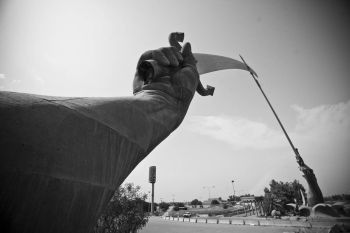 Crossed swords over Baghdad's military parade ground. Photo by Justin King, summer 2008. |
(WASHINGTON D.C.) - Two days ago, on the 8th Anniversary of the War on IRAQ, the USA and British submarines launched 112 Tomahawk cruise missiles on Libyan air defenses. All for the sake of democracy...
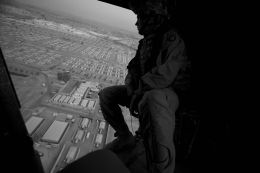 Over Baghdad- Photo by Justin King |
To commemorate the 8th anniversary of the war on IRAQ, the Baghdad airport battle on April 7 - 9, 2003 is remembered in this article written by Jeff Archer. It is from his book, "The Mother of All Battles: The Endless U.S.-Iraq War"
The U.S. preoccupation with the impending threat of Iraqi nuclear weapons was just another form of misinformation to rattle the American public. A few months after Desert Storm, the U.N. sent a secret team of nuclear inspectors to Iraq to try to discover how close Iraq was to producing its first nuclear weapon prior to the conflict. The experts were nuclear designers from the U.S., Russia, Britain and France.
Iraq’s nuclear program had already been scrutinized by U.N. inspectors, but this group was more advanced in its knowledge of nuclear weapons because it was comprised of design experts. The designers’ assessment was the most accurate that had been reported: “Iraq was at least five years away from developing its first crude nuclear weapon, if it desired to do so.” This message was opposite of that of George Bush, who created worldwide hysteria by saying Iraq was within months, or even weeks, of having a nuke ready to go
Like father, like son again was the rule of the day a dozen years later as Bush II spoke in detailed terms of Iraq’s impending nuclear threat and a “mushroom cloud over New York City.” Few journalists mentioned the 1991 report, or that Iraq’s nuclear weapons capability was totally destroyed in the bombing of Desert Storm.
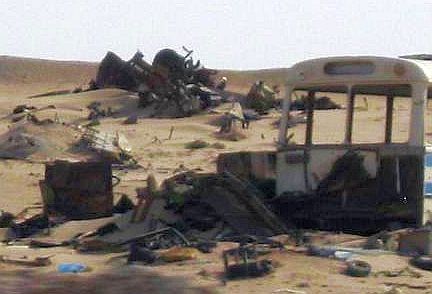 The highway from Kuwait to Iraq is still littered with the remnants of |
In the buildup to Desert Storm, no one seemed concerned about U.S. nuclear weapons. Many were shocked to learn that the U.S. used radioactive projectiles, made from spent uranium, against the Iraqis. When Desert Storm ended, several hundred tons of spent uranium were sitting in the desert in Kuwait and southern Iraq. Late in 1991, the British Atomic Energy Authority issued a secret report on the use of spent uranium in Desert Storm.
According to the document, uranium was used in tens of thousands of armor-piercing rounds fired at Iraqi vehicles by U.S. aircraft and U.S. and British tanks. According to Lt. Colonel Vincent Macchi, a combat commander in Desert Storm, “Every attack aircraft in the air and on the ground carried them.”
The Atomic Energy Authority went on to say that there was enough uranium in the deserts of Kuwait and Iraq to potentially cause 500,000 deaths. It added that the sheer volume of uranium did indicate a significant problem.
Depleted uranium is a derivative of the U-235 type used in weapons-grade materials. The less-radioactive, yet still dangerous, substance is then made into bullets, bombs or missiles that are extremely hard and heavy. The projectile then can easily cut through virtually any kind of armor.
When it pierces heavy armor, the outer surface of the round pulverizes, dispersing uranium dust that burns at very high temperatures. The depleted uranium rounds incinerated thousands of Iraqi tank crews.
Lt. Colonel Macchi said the projectiles were “the best tank killers we’ve ever seen. The trouble is, we’ve never used DU (depleted uranium) before and we had no idea what that aftereffect would be.”
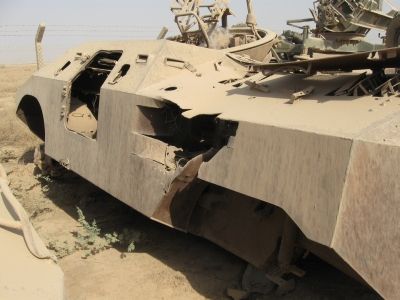 Hole in side of military vehicle could have been depleted uranium |
In August and September of 1991, a team of experts from the British Atomic Energy Authority visited the area of contamination and discovered that shell fragments, uranium dust, and other debris were left behind from the barrage of hi-tech shells used during Desert Storm. They concluded that there was enough low-yield radiation to present a “serious and ultimately lethal hazard to large population masses.”
In November 1991, the International Atomic Energy Committee issued a report to Gulf area diplomats with high security clearances that discussed the waste. One senior diplomat concluded: “Our air, our water, the soil, the food chain … everything … has been poisoned. My government supported the military intervention against Iraq, but now many of us wish we had opposed it.”
The U.S administration tried to keep the information about DU away from the American public. Most people had never heard of the new weapon and the U.S. government hoped that any information would just fade away, however, something occurred that made it difficult to push the information aside.
A few months after the end of Desert Storm, several hundred U.S. soldiers contracted a mysterious disease that confounded the doctors. Many theories came forth about the maladies — oil well fires, possible chemical weapons, handling of fuels, etc. Only after many U.S. military people came forward was the subject of radiation poisoning brought up.
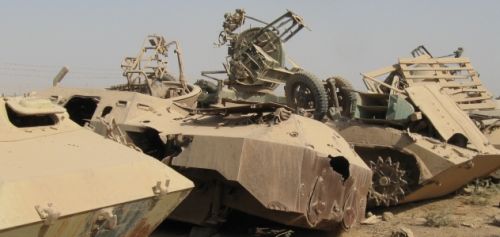 Tanks destroyed in battle in Iraq |
Initially, a few hundred U.S. Gulf War veterans complained about bleeding gums and liver disorders. Within a few months, the number exceeded 100,000. Many maintained that spent uranium was the cause of their sicknesses, yet the U.S. government lent no credence to this diagnosis. If it had, the government would have admitted that the hazardous materials were used en masse during Desert Storm.
The resulting contamination from the use of spent-uranium projectiles is horrific. After Desert Storm, thousands of Iraqis died in mysterious manners of which the causes point to the leftover spent uranium. In areas which the U.S. bombed heavily, there were more incidents than in areas which did not receive massive bombing. Children were (and still are) suffering and becoming deformed because of the spent uranium.
The March 2003 invasion brought even more DU to Iraq, possibly 10-times as much. The cycle began again. Some places are so immersed in DU that locals state they felt the heat from the exploded armaments months after they were dropped.
Not only Iraq suffered from these projectiles. In the 1999 bombing of Serbia, many similar missiles and bombs were used. On the ground, the results are identical to those in Iraq.
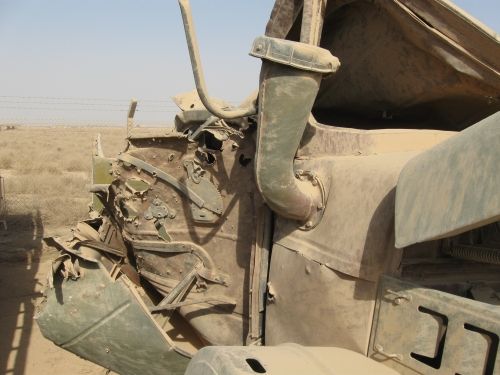 Another truck in Iraq that was extremely damaged in combat- there is no way to |
Despite the visits of many scientific teams to Iraq that have concluded that DU is a tragedy of a great scale for the Iraqis, three U.S. administrations refused to address the issue. They all said that DU is benign and have constantly stated that DU had nothing to do with U.S. war veterans who became ill or died.
The number of U.S. casualties possibly caused by DU is now in the hundreds of thousands. When the recipients brought up the issue with the U.S. government, they were rebuffed and told that DU is not dangerous and is not the cause of their illnesses, despite scientific research stating the opposite.
The U.S. did not use nuclear weapons in Iraq in 1991 or Serbia in 1999. However, there are thousands of tons of nuclear radioactive material in both countries.
There are hundreds of websites on the Internet that have very informative and astute information about the use and effects of DU. Just punch in “depleted uranium” in a search engine and you will be able to research the issue in much greater detail.
There are always some instances that have occurred in the ongoing U.S. war against Iraq that leave one with a feeling of not having gotten to the bottom of the story. Many times, research will provide the answers, but some things still stick out as unfinished business. One of these quandaries was the taking of Saddam International Airport (later renamed Baghdad International Airport by the U.S.) in early April 2003. Much of the news from the U.S. and British mainstream press said the airport fell with ease and few U.S. casualties.
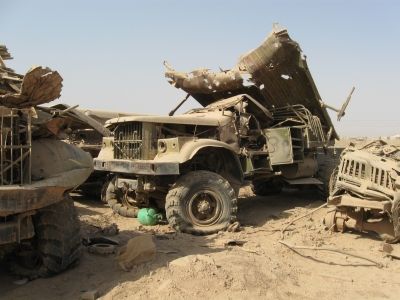 It's hard to determine which weapons were used, but this truck |
However, there were gaps in the reporting as well as contradictory statements. Initially, most press agencies or publications reported heavy fighting when the U.S. arrived at the airport. Then, there was silence. About four days later, we heard about the airport’s fall to the U.S. But, was it all as easy as the press stated?
Russian agencies carried stories of fierce fighting in which many U.S. soldiers were killed. Some Arab news agencies spoke of a bloody battle with heavy casualties on both sides. These reports varied greatly from those coming out of the U.S. and Britain.
In July 2006, an article written by Captain Eric May, a 14-year veteran of the U.S. Army, published by the Lone Star Iconoclast, alleged that the Battle of Baghdad, which began at Saddam International Airport, was far more devastating to the U.S. forces. This was no conspiracy theorist looking for publicity. Additionally, he held knowledge that few writers about Iraq have: keen expertise in the areas of military tactics and U.S. military intelligence.
Captain May made another allegation that was not mentioned in the mainstream press. He thought that the outnumbered U.S. military used a neutron bomb at the airport to stop the Iraqi troops.
Captain May entered the U.S. Army in 1977 and served for 14 years. He eventually received advance intelligence education and he spent years in deciphering messages, mainly from the former Soviet Union.
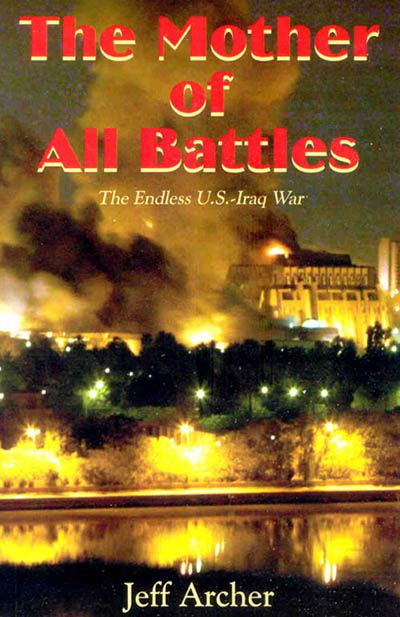 Click the image above to learn more and order a copy |
In 1990, he returned to civilian life and taught languages (Latin, Greek and Russian) at Mt. Carmel High School in Houston, where he was once named teacher of the year. In 1995, he changed careers and became a freelance executive speech writer for many prominent companies. At the same time, he contributed articles to Houston NBC-affiliate KPRC-TV. In addition, he wrote for two Houston daily newspapers: The Houston Post and The Houston Chronicle.
On August 26, 2006, I interviewed Captain May. He brought out some very interesting points about the battle at the airport that received little or no publicity in the U.S.
JA: Please tell us what prompted you to begin your questioning of the Battle of Baghdad, primarily the battle for the airport.
CM: I had just come back from teaching a martial arts class on Friday, April 4, 2003. That would have been the morning of April 5 in Baghdad. Immediately, what I saw on CNN, about 9 p.m. Central time, was that Baghdad had been surrounded. We had dedicated the military forces to enveloping and making it succumb piece-by-piece, maybe sending in the 101st Airborne.
Then, all of a sudden, there was a report of explosions and CNN started to act like they were all rattled and didn’t know it was coming. Given that I was a prior service and intelligence public affairs officer, I knew very well that meant unexpected contact. Pretty soon, they were saying there were huge explosions from the airport, and the next thing you know, they’re casting over to imbed Walter Rogers from CNN. As he’s broadcasting from Baghdad Airport, you can hear artillery hitting around his Humvee and you can hear small arms fire hitting it: a distinct ping, ping, ping. That pretty much told me they were getting fired up bad.
That was when it was still pre-dawn in Baghdad. By dawn, Lt. Col. Terry Ferrell, the 3/7 Cavalry Group commander appeared on TV during CNN evening coverage and he broke down into tears when he trying to say everything was okay at Baghdad Airport. That made it clear to me that the 3/7, the scout unit, the cavalry squadron that attended the 3rd Infantry Division, the U.S. Army division that had surrounded Baghdad, had wound up in a close fight in the Baghdad Airport. That’s what I picked up at the time.
By the next day, CNN was saying there was substantial contradiction in facts from various media reports. Arab media were putting out 200 U.S. dead at the airport. Russian Intel put out that dozens were dead and a real fight had developed. U.S. media were putting out that Jessica Lynch had been rescued.
JA: How do you account for foreign media reporting about a bloody battle and U.S. media being silent about the airport while highlighting the rescue of Jessica Lynch?
CM: To me, at this point, it was a done deal. The Battle of Baghdad was essentially blocked out from April 5 all the way through April 8. On April 9, you had the pull-down of the Saddam statue which represents a pretty efficient ending of the Battle of Baghdad. But, it really was a propaganda ending. The pull-down was a staged event and I’ve heard that the few Iraqis there were not even Iraqis.
JA: Why have you taken such passion about the Battle of Baghdad?
CM: The propaganda cover-up of the Battle of Baghdad, what we call BOBCUP (Battle of Baghdad Cover-up) was so conspicuously against the United States principles of information, which is what we follow in the Department of Defense Public Affairs operations, was so egregiously out of line, it was then that I self-mobilized my mission of conscience because, basically, it was apparent to me at that point, that we were under dictatorship. Suppressing the events of an entire battle and keeping it suppressed long after the battle was over … you know, you could have said, "Well, we didn’t want to tell the Iraqis where our troops were," or something else. But, you can’t say that months and months and months and years after the event.
Baghdad was the beginning. I’ve finished a successful career; in and out of the active Army and in and out of the reserves. My last gig was that of a general staff officer. I’ve been around. Baghdad brought me out of the observation and analysis of this war to a participant in what we call the "info war." The war to get real information to the public.
JA: Please describe the conditions that make an "info war."
CM: What became apparent to me is that the willingness they have to close down any kind of information that doesn’t fit into the big plan. Make it apparent that the whole system of government that we grew up studying in books — the three systems to keep government honest — has really become a unipolar government where you have an imperial executive — we call it King George and the Bush League — who rule the country. The media translate it like a propaganda ministry. Your other two parts of the triangle, the legislative and the judicial branches of government, are really there just for dressing up. They’re just there to make it look like a democracy, but it’s not. (Note: to non-U.S. readers, the term "bush league" in the U.S. represents a low-class entity. Captain May used the term doubly: Bush is the president’s name and fits right in with the Bush League.)
JA: You, like a few other people who can think, predicted in writing the outcome of the invasion. Please elaborate.
CM: I’ve been publishing war analyses for the Houston Chronicle since 1992 predicting this quagmire. In retrospect, now that things have turned out the way they have, it seems obvious what I wrote on April 3, 2003, as we were nearing Baghdad. I wrote in the Houston Chronicle that this would be called "The Quicksand War”: it would turn into quicksand. Now, that looks so transparently obvious. But, I can remember when I submitted it to my editor, he laughed at me and said I was really going to blow my reputation on this one because the U.S. Army was going to reach Baghdad the next day and prove I was wrong.
As with so many people who never served a day in uniform, he just automatically knew that once you got there and knocked the other guy’s capital down, they gave up. But, for somebody who’d been in the military at that time in three different decades, and who had studied the art of war for three decades, the idea that a war is over because you take a capital? I read Napoleon. Also, that’s what people were saying on the way to Moscow.
JA: What is your opinion about the Iraqi resistance at that time? Few people knew that it had been organized before the U.S. invasion.
CM: When we go into the Battle of Baghdad cover-up, that’s part of what was getting covered up. I was getting from Iraqi resistance reports that they were preparing a resistance movement and I picked up on this as the Battle of Baghdad was occurring. Groups like the Saddam Fedayeen were involved, not just the Iraqi military.
Teaching indigenous populations how to conduct guerilla warfare is like saying you have to teach teenagers on a date alone how to have sex. They’re inevitably going to find out what everything’s for if you just leave them alone. Anytime you start a guerilla war, you get involved in attacking and holding a country, the most brilliant work of that campaign is going to come from the people who are trying to get even for your initial attack.
The resistance was planned and according to my research, they were publishing an underground newsletter as early as the Battle of Baghdad itself. Covering up a battle and covering up military reality are only temporary advantages, but they bring long-term problems. The administration became invested in saying that it had a successful war with conclusive results. As a result, the entire paradigm was askew. It went in with the wrong policy in the military sense. Once you deny military reality enough, it screws up your military.
JA: Please explain in detail what you consider the info war and on what kind of battlefield will it be fought.
CM: It’s clear that we are in an info war. When Eisenhower warned of the military-industrial complex, he could have said, in Orwellian terms, the military-industrial-media complex.
The info wars are staged by such things as the manipulation of the capture of Saddam. I remember various media outlets grumbling about it because the story given by the U.S. administration was kind of falling apart.
With every story we discuss, information has been manipulated. If you listen to Rumsfeld, he will always say, "We need to win the propaganda war and we need to win the informational war." Informational warfare is nothing but info war. But, nobody wants to admit info war is going on because then it becomes clear that we have a treasonable condition of affairs.
JA: How can the numbers of U.S. killed in the Battle of Baghdad be covered up? How can they make four or five hundred soldiers disappear?
CM: That formed the first level of my investigation into the Battle of Baghdad. After watching CNN on April 4, 2003, I spent a couple of weeks doing TV analysis. Then, I decided I would go to Fort Stewart in Georgia, which is the home base for the Third Infantry and the 3/7 Cavalry.
When I got there, I immediately confirmed the existence of the Battle of Baghdad with the chaplain, who also told me the constitution was in the tank. They were covering up what they wanted. They control what the public feels, sees and does.
I realized there was a cover-up going on at the home base. Later in the summer, it came out that wives at the home base were being harassed and they were being given pharmacological psychotropic cocktails. There was a news blackout. When they (Third Infantry Division) finally did get back, they came back kind of on the midnight train.
There were many more wounded than the hospital could accommodate. They were sleeping in open fields. The reason for that, I believe, is that they were trying to keep everybody who was at the Battle of Baghdad all located at one Army post so they could control all the information.
Among the survivors and their dependents, there was an attempt to coerce silence. I like to say they were thugged up and drugged up.
In January 2004, I had a freelance journalist from upstate New York start working with me to try to get the story. She found out that there were about 100 backdoor visits, which means the casualty officer would come and inform the widows of what happened. They were taking women and getting them out of town, off the post.
She came up with a number of about 100 war widows. About one out of three soldiers is married. That kind of went well with what I had thought: about 300 to 500 killed in action. Very quickly, after she began investigating, she got a death threat.
Maybe we have 500 dead. That sounds like an immense pile. What happens is that you get 500 coffins that go to 500 different train terminals and 500 disparate cities and small towns. Nobody sends out a card saying there are 499 other ones. Everybody who gets one knows they have a dead G.I. But, nobody thinks their dead G.I. was part of a massive battle. It’s the elephant of truth. Every blind person gets one feel. Everyone gets one pat on the elephant without realizing there’s an immense beast there.
Covering up dead body counts is not hard to do at all. All you do is fail to report in any kind of cohesive order that there has been a massive battle. They proved that again by the fact that the fight of Fallujah, both of them, were covered up.
It’s easy to understand what happened with Fallujah. The same as the Battle of Baghdad. What the public got told was nothing like the carnage that was going on. The U.S. death count was held down. There’s no way you have street-to-street close urban combat dismounted and have only two guys a day getting killed. It doesn’t happen that way. We had regimental operations going on in Fallujah.
JA: If George Bush declared victory on May 1, 2003, why is there still fighting in Baghdad?
CM: The one thing we should understand is we have a Battle of Baghdad going on right now. It’s being covered up. It’s being hidden as a substratum under the greater story, which is the Israeli war on Lebanon.
As an example of what happens when you broadcast propaganda instead of history, the truth gets lost. The American public was told we took Baghdad far easier than we did and that meant clear sailing, when it really didn’t. Now, the American public has been deluded. It’s like a magic trick: once you follow the magician, you’re lost. The magician has control of you. The media is a magic trick. That TV is a box and the magic trick that comes out of it tells us that we’re reinforcing our troops around Baghdad so we can take Baghdad back. The screaming question should be, "What the hell? You mean we lost Baghdad?" We’ve been losing Baghdad since we got there.
JA: Have you spoken to any Iraqi participants of the Battle of Baghdad?
CM: A couple of journalists who were in Baghdad proper talked to the people returning from the battle. The most extreme thing I picked up is that the Battle of Baghdad was started at the airport with the U.S. forces being overwhelmed. It wound up being a six-hour firefight at close quarters and my surmise is that our side was running out of ammo and somebody decided to go nuclear. That seems to be universally acknowledged by everybody on all sides, except the American.
Evidently, what happened was the U.S. G.I.s buttoned up inside their armor, which cuts down the transmission of radiation, and some sort of nuclear devices were used at Baghdad Airport. Since then, American battle doctrine has been revised to allow commanders to do exactly the kind of things that I’m inferring from my sources that were done at Baghdad Airport. In other words, they retroactively retrofitted the doctrine.
The nuclear threshold is a very fuzzy thing in this war anyway. We already went over using D.U. (depleted uranium). That already, arguably, makes it a nuclear war. Of course, you see why Battle of Baghdad One had to be covered up. How the hell do you go into a war where you say you’re going to remove an evil madman because he has weapons of mass destruction and you bring them with you?
JA: In your opinion, did the U.S. do anything positive in removing Saddam Hussein and his government?
CM: You remember the first year of the war, the commentators were saying to the naysayers, "Well, what do you mean? Are you saying they’d be better off if Saddam was still in charge?" That was something that shut everybody up because, one year into this, everybody was still believing the myth that we freed the Iraqis. At this point, the reason why nobody asks if they’d be better off with Saddam in power is that it has been so transparent to anybody, except a Republican clone, that they were much better off when Saddam was in power.
JA: Do you think the truth will ever come out to the mainstream about the Battle of Baghdad?
CM: The mainstream seems to be irrelevant. They’ve condemned themselves. They find they formed a Faustian pact when they were all going to get behind a war that was for oil and Israel. They agreed to become an imbedded asset. What could be more shameful than to be imbedded? They’re not a media supplying relevant information. They’re a propaganda operation providing rationalization.
That’s what leaves us with the term "info war." Now, the relevant and important information comes out through what you might call the "underground media." Call it alternative media or what you want. What is means is that two guys, like you and me, who both have enough expertise to be on any of the network shows, talk about what we talk about. We can’t get on their TV, so we do it through this alternative medium. The best interviews that can be conducted are available outside the mainstream media. The ability of the people who are not plugged into the mainstream media system to do quality work means that the system will inevitably fail.
I compare it to the Catholic hierarchy after the creation of the printing press. The Internet, to us, has become our info war printing press. Information cannot be totally controlled. If you say, "I’m a gatekeeper and I’m plugging up this big old door," the Internet makes it such that information seeps out of the cracks.
What we call media, I call collaborators. All collaborators, throughout history, suffered the same fate. They lost all reputation and dignity after the victory by the right side.
It’s only at the point when the media have been exposed that the real history of the Iraq war will be written. You’re writing one now. Eventually, there will be acknowledgement of the Battle of Baghdad and the Battle of Fallujah. These things are being kept under wraps now because the very frail Bush League still maintains control of the equally frail imbedded media. That cannot endure.
Is it possible that the U.S. military used a neutron bomb against the Iraqi troops during the battle for the airport? Because the airport came under U.S. control, the world may never know. Some actions created bases worthy of further questioning. Shortly after the battle ended, many trucks laden with soil came to the scene and replaced dirt that had been dug up by the U.S. military in the airport. Then, the airport was off limits and did not open for nine months.
Reports did come out of Baghdad that there may have been an extraordinary event that quickly ended a fierce battle. According to Steven Salinsky in an article named “Arab and Muslim Jihad fighters in Iraq,” published by the Middle East Media Research Institute on July 27, 2003:
A Yemini volunteer said: “I was attached to a group of Arab volunteers in a residential neighborhood in western Baghdad a few days before its fall. When the American forces entered Saddam Airport, we were transferred willingly near there and found Iraqi forces belonging to the Republican Guard and infantry forces, which perhaps belonged to the Fedayeen, fighting ferocious battles several hundred meters from our position.
“The Iraqis fought fiercely in the battle at the airport, and the Americans moved under an aerial umbrella of fighter planes, helicopters and heavy bombing with missiles and giant bombs. It was a sight from hell, and hundreds of Iraqis and Arab volunteers were martyred.
This eyewitness report corroborates the scenario that the use of a neutron or other type special bomb would create in battle. In an article called “Iraq’s Secrets Are Tumbling Out,” published in the May 7, 2004 edition of the Indian Press, Saeed Naqvi wrote
A few days earlier, the colorful minister for information, Mohammed Sahaff, had threatened a “unique way” in which U.S. troops around Baghdad Airport would be “handled.” Two floors of the passenger areas were under American control. But Iraqis were still in occupation of VIP and service buildings. This is where the control valves were for water supply to the main passenger area where the Americans were. At night, petrol was pumped into the first floor. The ground floor of the passenger terminal was flooded with water. An 11 KV current passed through the water. The first floor was then set on fire causing the U.S. soldiers to rush downstairs — to be electrocuted. Heaven knows how many were killed.
To flush out the Iraqis from the remaining airport buildings, a neutron bomb was allegedly used. This enhanced radiation bomb spares buildings but reduces humans to ash. Iraqi Republican Guards, witness to this macabre display, informed the Ba’athist military leadership about the lengths to which the U.S. could go … Was this the reason why Baghdad Airport remained closed until nine months after the fall of Saddam Hussein’s statue on April 9, 2003?
On February 6, 2004, www.indybay.org ran an article by David Martinez titled, “Rumors and Rifles.” According to Martinez:
The first concerns the battle for the Baghdad airport. As you will remember, it was a fierce and bloody conflict, and at the end the Americans prevailed. But exactly HOW they won is being much speculated upon.
People say that there was a very loud explosion heard, and then after that, all resistance ceased. Then, eyewitnesses say, trucks were seen removing loads and loads of topsoil, as if it had been contaminated. And the families of the slain have asked for their relatives’ remains, to no avail. A British journalist told me he has seen photos of the corpses, and they are something akin to melted.
So, people think that the Americans used a small neutron bomb, a device that killed humans, but left buildings intact. It allowed the military to kill people without damaging real estate. A lot of folks here think that one of these was dusted off and used to wipe out the Iraqi fighters at the airport.
The media of various countries, such as Russia, India and some Arab nations, as well as journalists of the alternative sector, covered this story, but, no Western mainstream media approached the subject. Most of the reporting of the possible use of a neutron bomb by the U.S. against the defenders of the airport ceased about a year after the incident.
All that changed in April 2007. Someone close to the battle came forth and made the same allegations of those who had written about the use of a neutron bomb. Saifeddin Hassan Taha al-Rawi, the former commander of Iraq’s Republican Guard, was interviewed by Al-Jazeera News about the battle. Only al-Rawi’s back was visible in the interview and his face was covered because he is still on the run from the U.S. military. He is on the infamous set of playing cards the U.S. devised in 2003 as the Jack of Clubs. There is a one million dollar price tag on him.
According to an Al-Jazeera article of April 9, 2007, called “U.S. Accused of Using Neutron Bombs:”
Al-Rawi told Al-Jazeera that U.S. forces used neutron and phosphorus bombs during their assault on Baghdad Airport before the April 9 capture of the Iraqi capital.
“The enemy used neutron and phosphorus weapons against Baghdad Airport. There were bodies burnt to their bones,” he said. “The bombs annihilated soldiers but left the buildings and infrastructure at the airport intact,” he added
Various sources, from those who fought in the battle, to citizens in neighborhoods close to the airport, described a common scenario of fierce fighting, a huge noise accompanied by a massive flash, and an almost instant end to the fighting. Al-Rawi mentioned two weapons: a neutron bomb and a phosphorus bomb. The results of both fit the description of the melted bodies seen at the airport. In Fallujah, the U.S. used phosphorus bombs against the civilian population. At first, the allegations were denied, but, once pictures began to emerge from Fallujah showing melted Iraqi bodies, the U.S. administration admitted the use of phosphorus bombs, albeit the confession said they were only used to light up the battlefield.
We may never know the truth about the battle for Baghdad Airport because no Iraqis with cameras took pictures of the bodies of the dead. But, in Fallujah, pictures were taken and distributed so the world could see the melted corpses.
There is another possibility: fuel-air bombs, sometimes called fuel-air explosives (FAE). A common description of these weapons is “an atomic blast without the radiation.” This is not technically true, but the results resemble such an impact.
After Desert Storm, many Iraqi bodies were found that either were melted or incinerated to a pile of ashes. They were the recipients of fuel-air explosives. International rules of war state they can only be used to clear an area of the battlefield, such as a mine field, but not against personnel.
Despite the lethality of FAE, the public knows little about the weapon. Most people have heard of a neutron bomb or a phosphorus bomb, yet FAE, which are just as lethal, if not more so, remain unknown.
On March 12, 2002, the Weekly Standard published an article written by Victorino Matus called “Sucking the Oxygen Out of a Cave.” Matus explained:
Here’s how your average fuel-air bomb works: A warhead containing a canister of aerosol liquid such as ethylene oxide or an explosive powder is dropped on a target. “A small initial explosive charge bursts this canister at a predetermined height, allowing the contents to form a concentrated explosive vapor-cloud. This cloud is then ignited by a second larger charge, to generate an intense fireball and blast overpressure … Even if the FAE fails to detonate completely, it will generate a widespread burning effect,” says Jane’s (Defence Weekly). “The temperature can be as high as 3,000 degrees Celsius — more than twice that generated by a conventional explosive. The blast wave can travel at approximately 10,000 feet per second.”
Here is how the U.S. Defense Intelligence Agency (DIA) describes the effect of an FAE:
The (blast) kill mechanism against living targets is unique and unpleasant … What kills is the pressure wave, and more importantly, the subsequent rarefaction (vacuum), which ruptures the lungs. If the fuel deflagrates but does not detonate, victims will be severely burned and will probably also inhale the burning fuel. Since the most common FAE fuels, ethylene oxide and propylene oxide, are highly toxic, undetonated FAE should prove as lethal to personnel caught within the cloud.
We probably will never discover what the U.S. used against the Iraqi military in the battle for the airport. The effects of a neutron bomb and FAE are similar: instant death and melted bodies. Both produce a huge fireball, as described by witnesses, and a deafening sound.
Those who consider that the neutron bomb was the weapon of choice point out a factor that may sway the argument toward the atomic projectile. After the battle ceased, surrounding neighborhoods were measured for radiation levels. Those nearest the airport displayed elevated magnitudes of radiation. The levels decreased proportionately when checked in areas farther from the airport.
The thousands of tons of spent uranium in Iraq will poison the environment for millennia. Many groups have inspected the areas in which depleted uranium was used. It is no longer speculation, but fact.
The use of a neutron bomb is still open to debate, but many common statements by observers point in that direction. Either way, Iraq has been inundated with nuclear material from U.S. and British military actions. Both used nuclear weapons against Iraq.
One aspect of the battle for the airport that is never mentioned in the West is the participation by Iraq’s president. Iraq Screen published an article shortly before Saddam Hussein’s assassination in 2006. The author interviewed an Iraqi officer of the Republican Guard who participated in the battle for the airport in Baghdad in April 2003. The officer recalled:
While I was busy shooting with my colleagues, all of a sudden, we found Saddam Hussein with a number of his assistants inside the airport, we were really surprised because we did not expect such a thing, but Saddam went forward and took an RPG and put it on his shoulder and began to shoot by himself. We gathered around him and begged him to stay aside and leave us fighting because if we would be killed, we are common officers, but if he is killed, we would lose our leader. Saddam turned to us and said, "Look, I am no better than any one of you and this is the high time to defend our great Iraq and it would be a great honor to be killed as a martyr for the sake of Iraq."
Learn more: http://malcomlagauche.com/
Articles for March 20, 2011 | Articles for March 21, 2011 | Articles for March 22, 2011

Quick Links
DINING
Willamette UniversityGoudy Commons Cafe
Dine on the Queen
Willamette Queen Sternwheeler
MUST SEE SALEM
Oregon Capitol ToursCapitol History Gateway
Willamette River Ride
Willamette Queen Sternwheeler
Historic Home Tours:
Deepwood Museum
The Bush House
Gaiety Hollow Garden
AUCTIONS - APPRAISALS
Auction Masters & AppraisalsCONSTRUCTION SERVICES
Roofing and ContractingSheridan, Ore.
ONLINE SHOPPING
Special Occasion DressesAdvertise with Salem-News
Contact:AdSales@Salem-News.com

Salem-News.com:
googlec507860f6901db00.html

Terms of Service | Privacy Policy
All comments and messages are approved by people and self promotional links or unacceptable comments are denied.
[Return to Top]
©2025 Salem-News.com. All opinions expressed in this article are those of the author and do not necessarily reflect those of Salem-News.com.